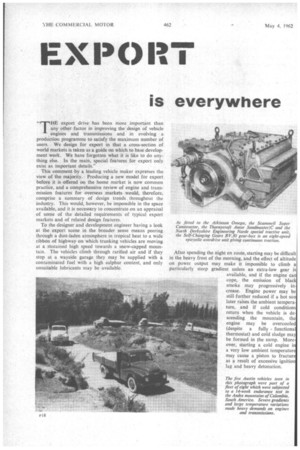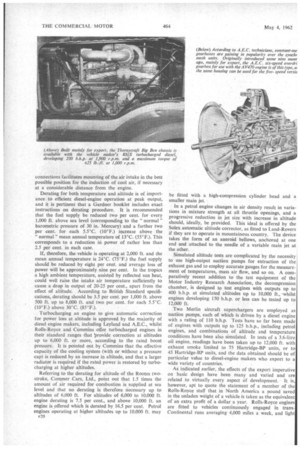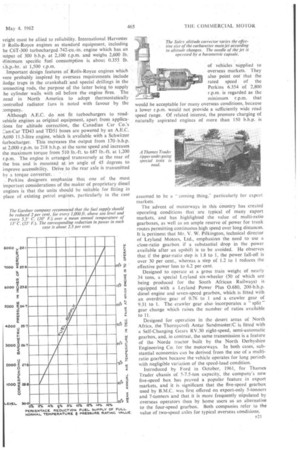EXPORT
Page 100

Page 101

Page 102

Page 103

If you've noticed an error in this article please click here to report it so we can fix it.
is everywhere
By P. A. C. BROCKINGTON, T
" HE export drive has been more important than any other factor in improving the design of vehicle engines and transmissions and in evolving a production programme to satisfy the maximum number of users. We design for export in that a cross-section of world markets is taken as a guide on which to base development work. We have forgotten what it is like to do anything else. In the main, special features for export only exist as important details."
This comment by a leading vehicle maker expresses the view of the majority. Producing a new model for export before it is offered on the home market is now common practice, and a comprehensive review of engine and transmission features for overseas markets would, therefore, comprise a summary of design trends, throughout the industry. This would, however, be impossible in the space available, and it is necessary to concentrate on an appraisal of some of the detailed requirements of typical export markets and of related design features.
To the designer and development engineer having a look at the export scene in the broader sense means peering through a dust-laden atmosphere in tropical heat to a wide ribbon of highway on which trunking vehicles are moving at a sustained high speed towards a snow-capped mountain. The vehicles climb through rarified air and if they stop at a wayside garage they may be supplied with a contaminated fuel with a high sulphur content, and only unsuitable lubricants may be available. After spending the night en route, starting may be difficult in the heavy frost of the morning, and the effect of altitude on power output may make it impossible to climb a particularly steep gradient unless an extra-low gear is available, and if the engine can cope, the emission of blac smoke may progressively in crease. Engine power may be still further reduced if a hot su later raises the ambient tempera ture, and if cold conditions return when the vehicle is descending the mountain, the engine may be overcoole (despite a fully functions thermostat) and cold sludge ma be formed in the sump. More over, starting a cold engine a very low ambient temperatur may cause a piston to fractur as a result of excessive ignitio lag and heavy detonation. This rather whimsical portrayal of the export vista indicates some of the detailed problems related to engines and transmissions that face a manufacturer in supplying vehicles to overseas markets. Extremes of temperature (and humidity), heavy air pollution, large variations in altitude, and continuous high-speed operation with an overload are conditions that apply separately, or are combined, in a particular area. In a typical case, however, the requirements of the operator can be satisfied if the range of standard vehicles available is sufficiently comprehensive with respect of the power produced at the wheels and if the manufacturer or distributor makes full provision for efficient air filtration, engine de-rating for temperature and altitude, the control of coolant and lubricant temperatures, and the supply of suitable oils and fuels.
Engine starting and temperature control in Arctic conditions are problems that apply to a very small proportion of vehicle users, and operators normally have a thorough knowledge of the specialized equipment required. In cold, but less severe climates the majority of modern engines start easily without special aids if the battery and starter motor are of sufficient capacity, although,• as indicated earlier, near-Arctic ambient temperatures can cause destructive detonation during the first phase of starting if the intake is aspirated direct from the atmosphere: " Overcooling the engine when the vehicle is travelling light is often the main problem, and it is significant that technicians of the Cummins engine company approve the use of thermostatically controlled radiator shutters, as well as a thermostatically controlled fan for colder climates. They point out that an engine can be overcooled by the direct air draught of the fan with the thermostat closed. Although an oil-water heat-exchanger is normally fitted by engine makers to cater for high-temperature operation, such a unit can be a valuable aid to low-load running in low temperatures, because it reduces the oil warm-up period and eliminates the danger of overcooling the lubricant.
It is significant that this merit of an oil cooler is particularly mentioned by Foden in the specifications of their new Dynamic fourand six-cylinder two-stroke engines, the specific power output of which is 36.5 b.h.p. per litre. Following a current trend (and an established practice of the company) these engines •are equipped with reticular, aluminium-tin, thin-shell main and big-end bearings, which promote a long wearing -life in arduous operating conditions. A.E.G. fit these bearings to their 470-cu.-in: power unit (which can be uprated from 112 b.h.p.. at 2,000 r.p.m. to 128 b.h.p. at 2,200 r.p.tn.) in place of the thick-shell tyPe, to provide easy maintenance combined with long life..• Whilst efficient air filtration does nof pose a difficult design problem, ease of servicing is of particular importance overseas, and haphazard positioning in vehicles equipped With locally-made bodies may be serious where dust concentration or heating of the intake air' are involved.
,A.E.C.-are• among those who fit a centrifugal vane-type pre-filter, and it is notable that they developed a drop-outbowl type of oil-bath main filter some years ago for underfloor-engined passenger vehicles tO proinote ease . of Maintenance. This was later applied to goods vehicles destined for overseas markets. Special mention is made by Gardner's, in the specification of the Gardner-designed Universal oil-bath filter, that the use of canvas flexible hose
connections facilitates mounting of the air intake in the best possible position for the induction of cool air, if necessary at a considerable distance from the engine.
Derating for both temperature and altitude is of importance to efficient diesel-engine operation at peak output, and it is pertinent that a Gardner booklet includes exact instructions on derating procedure. It is recommended that the fuel supply be reduced two per cent. for every 1,000 ft. above sea level (corresponding to the " normal " barometric pressure of 30 in. Mercury) and a further two per cent. for each 5.5°C. (10°F.) increase above the " normal " mean annual temperature of 13°C. (55°F.). This corresponds to a reduction in power of rather less than 2.5 per cent. in each case.
If, therefore, the vehicle is operating at 2,000 ft. and the mean annual temperature is 24°C. (75°F.) the fuel supply should be reduced by eight per cent, and average loss of power will be approximately nine per cent. In the tropics a high ambient temperature, assisted by reflected sun heat, could well raise the intake air temperature sufficiently to cause a drop in output of 20-25 per cent., apart from the effect of altitude. According to British Standard specifications, derating should be 3.5 per cent. per 1,000 ft. above 500 ft. up to 8,000 ft. and two per cent. for each 5.5°C. (10°F.) above 30°C. (85°F.).
Turbocharging an engine to give automatic correction for power loss at altitude is approved by the majority of diesel engine makers, including Leyland and A.E.C., whilst Rolls-Royce and Cummins offer turbocharged engines in their standard ranges that 'provide correction at altitudes up to 6,000 ft. or more, according to the rated boost pressure. It is pointed out by Cummins that the effective capacity of the cooling system (with or without a pressure cap) is reduced by an increase in altitude, and that a larger radiator is required if the rated power is restored by turbocharging at higher altitudes.
Referring to the derating for altitude of the Rootes twostroke, Commer Cars, Ltd., point out that 1.5 times the amount of air required for combustion is supplied at sea level and that no derating is therefore necessary up to altitudes of 6,000 ft. For altitudes of 6,000 to 10,000 ft. engine derating is 7.5 per cent., and above 10,000 ft. an engine is offered which is derated by 16.5 per cent. Petrol engines operating at higher altitudes up to 10,000 fi may F20 be fitted with a high-compression cylinder head and a smaller main jet.
In a petrol engine changes in air density result in variations in mixture strength at all throttle openings, and a progressive reduction in jet size with increase in altitude should, ideally, be provided. This ideal is offered by the Solex automatic altitude corrector, as fitted to Land-Rovers if they are to operate in mountainous country. The device takes the form of an aneroid bellows, anchored at one end and attached to the needle of a variable main jet at the other.
Simulated altitude tests are complicated by the necessity to use high-output suction pumps for extraction of the exhaust gas and to employ accurate gauges for the measurement of temperatures, mass air flow, and so on. A comparatively recent addition to the test equipment of the Motor Industry Research Association, the decompression chamber, is designed to test engines with outputs up to 400 b.h.p. at simulated altitudes up to 10,000 ft., .whilst engines developing 150 b.h.p. or less can be tested up to 12,000 ft.
Two Merlin aircraft superchargers are employed as suction pumps, each of which is driven by a diesel engine with a rating of 110 b.h.p. Tests have so far been made of engines with outputs up to 125 b.h.p., including petrol engines, and combinations of altitude and temperature conditions have been also simulated. In tests of a 3.6-litre oil engine, readings have been taken up to 12,000 ft. with exhaust smoke limited to 75 Hartridge-BP units, or to 45 Hartridge-BP units, and the data obtained should be of particular value to diesel-engine makers who export to a wide variety of countries.
As indicated earlier, the effects of the export imperative on basic design have been many and varied and are related to virtually every aspect of development. It is, however, apt to quote the statement of a member of the Rolls-Royce staff that in North America a pound saved in the unladen weight of a vehicle is taken as the equivalent of an extra profit of a dollar a year. Rolls-Royce engines are fitted to vehicles continuously engaged in transContinental runs averaging 4,000 miles a week, and light veight must be allied to reliability. International Harvester it Rolls-Royce engines as standard equipment, including he C6T-300 turbocharged 742-cu.-in. engine which has an mtput of 300 b.h.p. at 2,100 r.p.m. and weighs 2,600 lb. vlinimum specific fuel consumption is about 0.355 lb. ).14.-hr. at 1,500 r.p.m.
Important design features of Rolls-Royce engines which vere probably inspired by overseas requirements include Judge traps in the crankshaft and special drillings in the :..onnecting rods, the purpose of the latter being to supply :he cylinder walls with oil before the engine fires. •The rend in North America to adopt thermostatically :ontrolled radiator fans is noted with favour by the ..:ompany.
Although A.E.C. do not fit turbochargers to roadvehicle engines as original equipment, apart from applications for altitude correction, the Canadian Car Co.'s :an-Car TD43 and TD51 buses are powered by an A.E.C. A690 11.3-litre engine, which is available with a Schwitzer t/urbocharger. This increases the output from 170. b.h.p. at 2,000 r.p.m. to 218 b.h.p. at the same speed and increases the maximum torque from 510 lb.-ft. to 687 lb.-ft. at 1,200 r.p.m. The engine is arranged transversely at the rear of the bus and is mounted at an angle of 45 degrees to improve accessibility. Drive to the rear axle is transmitted
by a torque converter.
. Perkins designers emphasize that one of the most important considerations of the maker of proprietary diesel engines is that the units should be suitable for fitting in place of existing petrol engines, particularly in the case
of vehicles supplied to overseas markets. They also point out that the rated speed of the Perkins 6.354 of 2,800 r.p.m. is regarded as the minimum r.p.m. that would be acceptable for many overseas conditions, because a lower r.p.m. would not provide a sufficiently wide road speed range. Of related interest; the pressure charging of naturally aspirated engines of more than 150 b.h.p. is
assumed to be a "coming thing, particularly for export markets.
The advent of motorways in this Country has created operating conditions that are typical of many export markets, and has highlighted the value of multi-ratio gearboxes, as well as an ample reserve of power for trunk routes permitting continuous high speed over long distances. It is pertinent that Mr. V. W. Pilkington, technical director of Leyland Motors, Ltd., emphasizes the need to use a close-ratio gearbox if a substantial drop in the power available after an upshift is to be avoided. He observes that if the gear-ratio step is 1.8 to 1, the power fall-off is over 30 per cent., whereas a step of 1.2 to 1 reduces the effective power loss to 6,2 per cent.
Designed to operate at a gross train weight of nearly 34 tons, a special Leyland six-wheeler (50 of which are being produced for the South African Railways) is equipped with a Leyland Power Plus 0.680, 200-b.h.p. diesel engine and seven-speed gearbox, which is fitted with an overdrive gear of 0.76 to 1 and a crawler gear of 9.31 to 1. The crawler gear alsoincorporates a " split " gear change which raises the number of ratios available to 11.
Designed for operation in the desert areas of North Africa, the Thornycroft Antar Sandmaster/C is fitted with a Self-Changing Gears RV.30 eight-speed, semi-automatic gearbox, and, in contrast, the same transmission is a feature of the Norde tractor built by the North Derbyshire Engineering Co. for the motorways. In both cases, substantial economies can be derived from the use of a multiratio gearbox because the vehicle operates for long periods with negligible variation of the speed-load condition.
Introduced by Ford in October, 1961, for Thames Trader chassis of 5-7.5-ton capacity, the company's new five-speed box has proved a popular feature in export markets, and it is significant that the five-speed gearbox used by B.M.C. was first offered on export-only 5-tonners and 7-tonners and that it is more frequently stipulated by overseas operators than by home users as an alternative to the four-speed gearbox. Both companies refer to the value of two-speed axles for typical overseas conditions.


































































































































































































































































